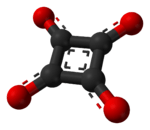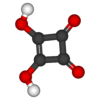Squaric acid
| |||
| Names | |||
|---|---|---|---|
| IUPAC name
3,4-Dihydroxycyclobut-3-ene-1,2-dione | |||
| Other names
Quadratic acid | |||
| Identifiers | |||
| 2892-51-5 | |||
| ChemSpider | 16919 | ||
| |||
| Jmol-3D images | Image | ||
| PubChem | 17913 | ||
| |||
| Properties | |||
| Molecular formula |
C4H2O4 | ||
| Molar mass | 114.06 g·mol−1 | ||
| Appearance | Gray powder | ||
| Melting point | > 300 °C (572 °F; 573 K) | ||
| Acidity (pKa) | 1.5, 3.4 | ||
| Hazards | |||
| R-phrases | R36/37/38 R43 | ||
| S-phrases | S26 S36 | ||
| Flash point | 190 °C (374 °F; 463 K)[2] | ||
| Except where noted otherwise, data is given for materials in their standard state (at 25 °C (77 °F), 100 kPa) | |||
| | |||
| Infobox references | |||
Squaric acid, also called quadratic acid, because its four carbon atoms approximately form a square, is an organic compound with chemical formula C4H2O4.
The conjugate base of squaric acid is the hydrogensquarate anion C4HO4−; and the conjugate base of the hydrogensquarate anion is the divalent squarate anion C4O42−. This is one of the oxocarbon anions, which consist only of carbon and oxygen.
Squaric acid is a reagent for chemical synthesis, used for instance to make photosensitive squaraine dyes and inhibitors of protein tyrosine phosphatases.
Chemical properties
Squaric acid is a white crystalline powder with a thermal decomposition point of 245 °C at ambient pressure.[3] The onset of thermal decomposition depends on the different thermodynamic conditions such as heating rates.
The structure of squaric acid is not a perfect square, as the carbon–carbon bond lengths are not quite equal. The high acidity with pKa = 1.5 for the first proton and pKa = 3.4 for the second is attributable to resonance stabilization of the anion.[4] Because the negative charges are equally distributed between each oxygen atom, the dianion of squaric acid is completely symmetrical (unlike squaric acid itself) with all C-C and C-O bond lengths identical.


Another, quantum mechanical, way of describing the dianion is to assume that the π electrons of the two double-bonded oxygen atoms are shifted to the latter, so that all four oxygens become single-bonded -O− groups and a double positive electric charge is left in the ring of carbon atoms. In this way the ring fits Hückel's rule for aromaticity (2 π-electrons = 4n + 2 with n = 0). The total symmetry of the dianion is a consequence of charge distribution and aromaticity.
On the other hand, theoretical calculations indicate that the analogous tetrathiosquarate anion C
4S2−
4 is anti-aromatic.[5]
Derivatives
Cobalt(II) squarate hydrate Co(C4O4)(H2O)2 (yellow, cubic) can be prepared by autoclaving cobalt(II) hydroxide and squaric acid in water at 200 °C. The water is bound to the cobalt atom, and the crystal structure consists of a cubic arrangement of hollow cells, whose walls are either six squarate anions (leaving a 7 Å wide void) or several water molecules (leaving a 5 Å void).[6]
Cobalt(II) squarate dihydroxide Co3(OH)2(C4O4)2 3H2O (brown) is obtained together with the previous compound. It has a columnar structure including channels filled with water molecules; these can be removed and replaced without destroying the crystal structure. The chains are ferromagnetic; they are coupled antiferromagnetically in the hydrated form, ferromagnetically in the anhydrous form.[6]
The same method yields iron(II) squarate dihydroxide Fe2(OH)2(C4O4) (light brown).[6]
One or both of the oxygen (=O) groups in the squarate anion can be replaced by other chalcogenides such as sulfur or other divalent groups, such as dicyanomethylene =C(CN)2. The resulting anions, such as 1,2-bis(dicyanomethylene)squarate and 1,3-bis(dicyanomethylene)squarate, retain the aromatic character of squarate and have been called pseudo-oxocarbon anions. There have been theoretical investigations of the analogous compound obtained by substituting amino groups (-NH2) for the hydroxyl (OH) groups to yield 1,2-diamino-3-cyclobutenedione, and of a compound consisting of two squarate rings bridged by (-NH-) bonds to form bis(3-cyclobutene-1,2-dione)piperazine.[7]
Syntheses
The original synthesis started from reaction of 1-chloro-1,2,2-trifluoroethylene with zinc to perfluorocyclobutene. This compound was converted to 1,2-diethoxy-3,3,4,4-tetrafluoro-1-cyclobutene with ethanol. Hydrolysis gives the squaric acid.[8]
Squarate and related anions such deltate C
3O2−
3 and acetylenediolate C
2O2−
2 have been obtained from carbon monoxide under mild conditions by reductive coupling of CO ligands in organouranium complexes.[9] A similar route recently afforded carbonate anions (in the form of uranium(IV) carbonate) from carbon dioxide CO2.[10]
Medical uses
Medically, squaric acid dibutylester is used for the treatment of warts.[11] Squaric acid dibutylester is also used for treating alopecia areata or alopecia totalis/universalis (autoimmune hair loss) through topical immunotherapy involving the production of an allergic rash.[12] Squaric acid dibutylester is currently undergoing trials for use in treating herpes labialis (cold sores).[13]
See also
- Cyclobutene, C
4H
6 - Deltic acid, C
3H
2O
3 - Croconic acid, C
5H
2O
5 - Rhodizonic acid, C
6H
2O
6 - Squaramides, the amides of squaric acids
References
- ↑ 3,4-Dihydroxy-3-cyclobutene-1,2-dione. Sigma-Aldrich
- ↑ 3,4-Dihydroxy-3-cyclobutene-1,2-dione, 98+%. Alfa Aesar
- ↑ K.-S. Lee, J. J. Kweon, I.-H. Oh, C. E. Lee (2012) "Polymorphic phase transition and thermal stability in squaric acid (H
2C
4O
4)". J. Phys. Chem. Solids 73 (7): 890–895. doi:10.1016/j.jpcs.2012.02.013 - ↑ Robert West and David L. Powell (1963), New Aromatic Anions. III. Molecular Orbital Calculations on Oxygenated Anions J. Am. Chem. Soc. volume 85 issue 17, pages 2577–2579.
- ↑ Reza Ghiasi and Majid Monajjemi (2007), Theoretical study of interaction of alkaline earth metal with C
4O2−
4 and C
4S2−
4: structure, electronic properties and aromaticity. Journal of Sulfur Chemistry, Volume 28, Issue 6, pages 537–546 doi:10.1080/17415990701561263 - ↑ 6.0 6.1 6.2 Hitoshi Kumagai, Hideo Sobukawa, and Mohamedally Kurmoo (2008), Hydrothermal syntheses, structures and magnetic properties of coordination frameworks of divalent transition metals. Journal of Materials Science volume 43, pages 2123–2130. doi:10.1007/s10853-007-2033-8
- ↑ Zhao-Ming Xue, Jian-Jun Cheng, and Chun-Hua Chen (2006), Theoretical study of the gas-phase acidity and aromaticity of a novel derivative of nitrogen squaric acid . Journal of Molecular Structure: THEOCHEM, Volume 763, Issues 1–3, pages 181–186 doi:10.1016/j.theochem.2006.01.026
- ↑ J. D. Park, S. Cohen, and J. R. Lacher (1962). "Hydrolysis Reactions of Halogenated Cyclobutene Ethers: Synthesis of Diketocyclobutenediol". J. Am. Chem. Soc. 84 (15): 2919–2922. doi:10.1021/ja00874a015.
- ↑ Alistair S. Frey, F. Geoffrey N. Cloke, Peter B. Hitchcock (2008), Mechanistic Studies on the Reductive Cyclooligomerisation of CO by U(III) Mixed Sandwich Complexes; the Molecular Structure of [(U(η-C8H6{Si'Pr3-1,4}2)(η-Cp*)]2(μ-η1:η1-C2O2) Journal of the American Chemical Society, volume 130, issue 42, pages 13816–13817. doi:10.1021/ja8059792
- ↑ Owen T. Summerscales, Alistair S. P. Frey, F. Geoffrey N. Cloke, and Peter B. Hitchcock (2009), Reductive disproportionation of carbon dioxide to carbonate and squarate products using a mixed-sandwich U(III) complex. Chemical Communications, pages 198–200 doi:10.1039/b815576c
- ↑ Warts. Wilmingtondermatologycenter.com. Retrieved on 2011-10-23.
- ↑ A. M. Holzer, L. L. Kaplan, W. R. Levis (2006). "Haptens as drugs: contact allergens are powerful topical immunomodulators". J. Drugs. Dermatol. 5 (5): 410–416. PMID 16703776.
- ↑ http://clinicaltrials.gov/show/NCT01971385

